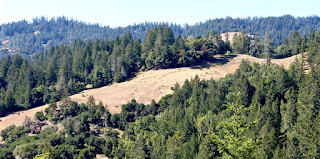CityZen Retreat
A group of us are just back from sesshin, a traditional Zen retreat. In case you've ever wondered what sesshin is like, I thought I'd share some pictures, descriptions, and vignettes from this recent retreat.
This sesshin lasted for five days and nights, and was held in the forest-fringed hills of western Sonoma County, at Lydia House, St. Dorothy's Rest, a lovely old retreat center perched at the crest of a bluff. Our sesshins are held in conjunction with CityZen of Santa Rosa, a sister group lead by Rachel Mansfield-Howlett, Roshi. At St. Dot's we had a zendo overlooking the golden hills, a great room with a roaring fire in the mornings and evenings, a big kitchen, simple but comfortable lodging, plus miles of trails for wandering during breaks. It's a beautiful and serene setting, and a place some of us have been coming back to for decades. Not to mention a welcoming and mature group of practitioners.
Sesshin is a very structured environment; almost every minute is accounted for. People often think this sounds hard, but it's actually incredibly liberating; you don't need to make many decisions about how to spend your time, and you are completely free to focus on what is happening right now. We keep silence, which means no chatting, no social greetings, though we do talk as needed to do jobs, ask questions, or to speak with the teacher about our practice. Here's a walk through the typical sesshin day.
We rise at 4:30 am, and are seated in the zendo (meditation hall) by 5 for tea. Early morning meditation may be my favorite time. We begin with only candle light, and watch as the dawn slowly breaks over the hills. It feels really silent and still and dreamy. We always alternate rounds of seated meditation with periods of walking meditation, to stretch our bodies and keep the energy moving. By the time breakfast is served at 7, magenta clouds are streaked across the sky. All our meals are in silence, which offers an opportunity to really savor the food. After each meal,there is a break, during which we may nap, shower, walk, write, paint, or do work practice.
A word about the food! We are fortunate to have a wonderful tenzo (head cook) Vikki Kath, who sources fresh local produce to provide delicious vegetarian meals. No sacrifice, no macrobiotics! There is plenty of great food, and yes, you can get a cup of coffee! Most of us work in the kitchen at some point during the day, helping chop veggies, cook, and clean up, Kitchen practice is a great way to extend meditation into activity, and is a highlight of sesshin for many of us.
We gather again at 9 am, and start the mid-morning by chanting our sutra service. It's mostly in English, so quite accessible, and is a lovely way to touch into the key teachings of our Zen tradition. Our chanting and singing is accompanied by guitar and drums. It feels great to use our voices and really sing out! After the sutras, we continue to alternate sitting and walking meditation until lunch. There is also an opportunity for dokusan (individual meetings with the teacher to discuss one's practice). Most of us have dokusan once a day during sesshin.
After the lunch break (a great time for a hike!) we begin the afternoon with a dharma talk by a senior student or teacher, often followed by a conversation. Then we settle in for more meditation. Late in the afternoon we take a long outside walk together, taking our walking meditation into nature. There is more opportunity for dokusan in the afternoon as well. By the time the shadows start to get long, it's time for dinner!
In the evening, after the dinner break, we gather by a roaring fire for a dharma talk by the Roshi (senior teacher). It's a chance to get inspired about the practice, to bring questions, and to learn more about this Way. There is more meditation before our evening closing ceremony, which is a lovely mix of bells, chants, bows, and words. We are done for the day by 9 pm, and most of us are in bed shortly thereafter!
So, that's the outer form. What's the inner experience like? That's different each time, and for each person. Many people experience great silence. Sometimes old wounds come up to be healed. And sometimes people catch a piece of the light, the light of our true nature, which we already have but can feel elusive in everyday life. If you're curious, come sit with us on a Sunday night, and ask about our next sesshin in May!








































